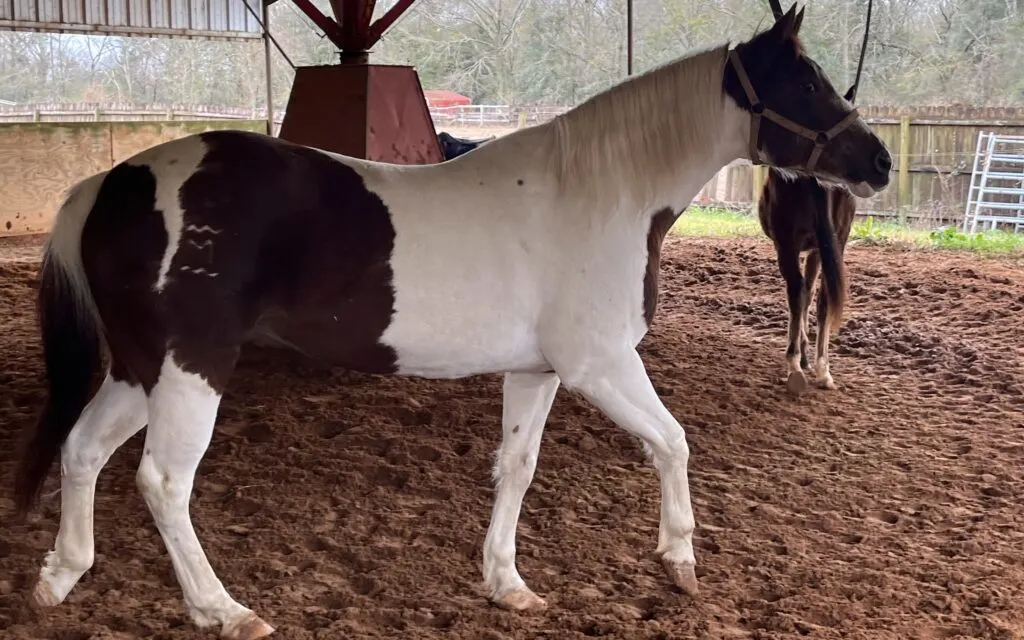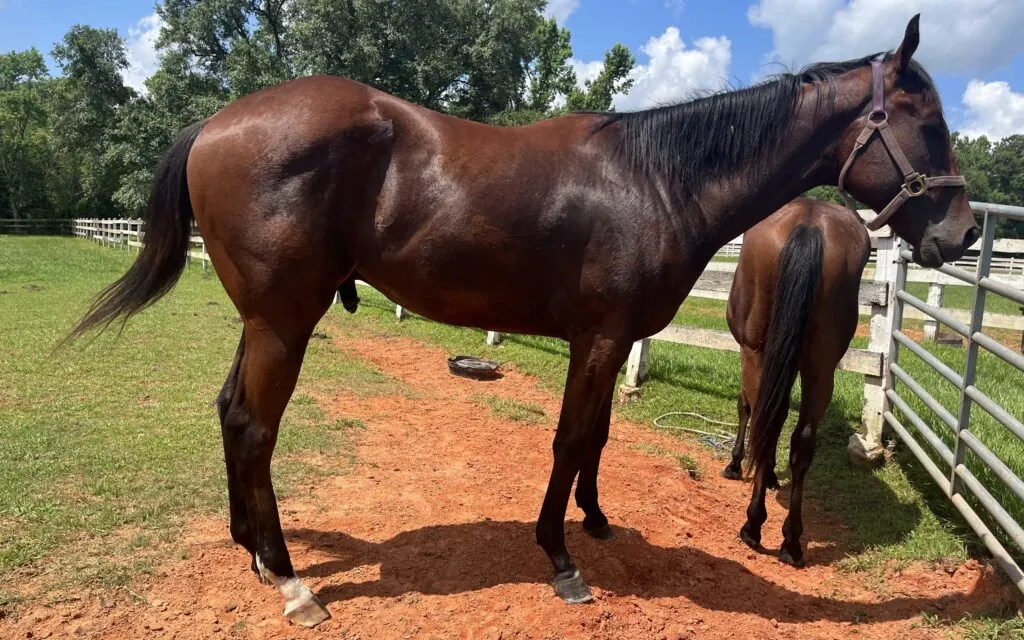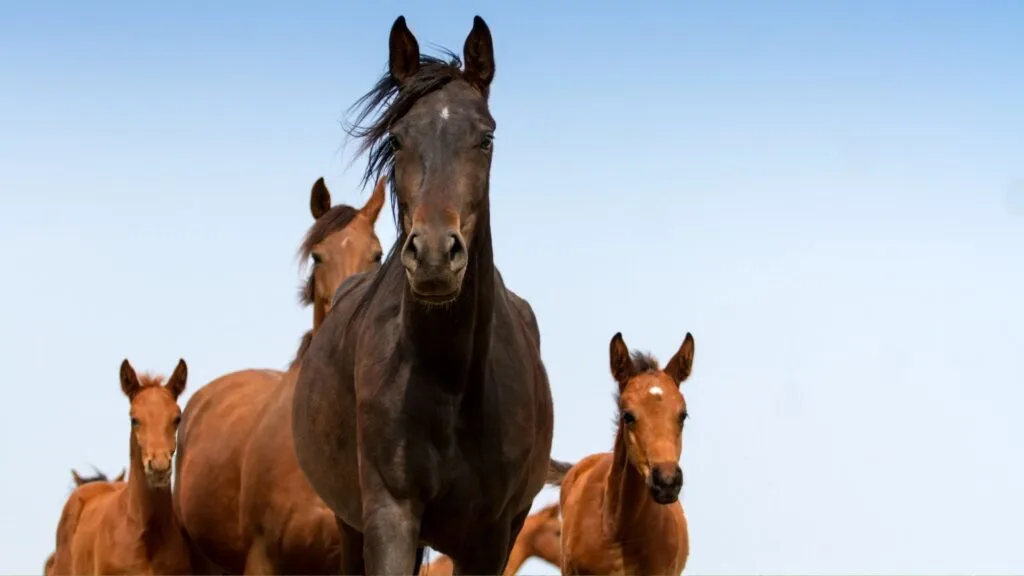Last updated: April 17, 2023
Any links on this page that lead to products on Amazon are affiliate links and I earn a commission if you make a purchase. Thanks in advance – I really appreciate it!
A horse owner’s life can be full of joy and fulfillment as you watch your mare produce healthy foals destined for success, but at some point, we will need to face reality. It takes a lot out of her body every time she gives birth, so what is the oldest a horse can breed?
In general, mares can breed until they are 25 years old, and male horses can breed up to 30 years old. But some horses may stop breeding either much younger or older depending on their health, fertility, and history.
Many horse owners have a mare that they love and have produced many great babies, but when will she stop having foals? There is no clear answer, but we can look at what is common for most horses.
How long can a horse continue to breed?
Horse owners often wonder how long their horses can continue to breed. The answer depends on a number of factors, including the horse’s age, health, and reproductive history.
On average, most horses will reach their peak breeding years between the ages of four and six. However, some horses may be able to breed until they are in their early twenties or even older. With proper care and management, most horses can enjoy a long and healthy breeding career.

Breeding old mares: How old is too old?
A mare can produce foals well into her teens or early twenties, but age affects her fertility. Mares typically have their best years of fertility between the ages of four and eleven. Unfortunately, as they get older, they become more challenging to get in foal, and the rate of pregnancy loss increases.
Older mares have about a 30 percent chance of getting pregnant when bred during their estrous cycle; because of this, they often have to be bred multiple times to conceive.
Once a mare reaches her late teens, they may develop one or more physical problems that can adversely affect fertility – such as infections and false pregnancies around the time they go into heat.
Some other common problems associated with breeding that older mares face are a lack of egg production and changes in their anatomy, specifically the reproductive tract. The reproductive tract includes the vulva, vagina, cervix, uterus, oviducts, and ovaries.
Uterus infections are common in mares over 12 years old and are caused by pooling urine, which leads to poor fertility. This occurs because, over time, the suspensory ligaments holding the uterus weaken and allows it to tilt (changes in her anatomy).
Older mares may also have an inward sloping of the vulva and lose muscle tone. When this happens, a lot of unpleasant things can get trapped in it, which can hinder conception.
Breeding a mare that’s too old may also cause additional health risks if it’s past its prime age to reproduce, associated with physically carrying a baby.
All these adverse issues are prevalent in aged mares, and once they are in their 20s, the chances of conceiving and carrying a foal to full term are very low. For these reasons, many breeders choose not to breed mares past 17 years old.

I often see old mares offered for sale at low prices by professional horse breeders because the cost of vet bills can be so high compared to the chances of delivering a healthy foal. Some breeders will give away a broodmare when she is 17 years old, even though she may still be able to have babies.
Large breeders look at their profit and loss sheets, not the individual horse. For example, near us is a corporate breeding farm with hundreds of broodmares, and they have a policy of getting rid of them at a certain age. Some of these horses are still viable for small farms.
Getting broodmares from breeders is an excellent opportunity to get into breeding horses. Most of these horses can continue to have babies, especially if they are healthy and had a successful broodmare career.
Most good broodmares, with proper care, can continue to produce healthy offspring well into their 20s and even 30s. Just remember that some older mares have a harder time conceiving than younger mares, and they are also more likely to experience problems during pregnancy.
Ultimately, the decision of when to retire a mare from breeding is up to the owner and should be based on the individual mare’s health and reproductive history.
Breeding older maiden mares
A maiden mare is a horse that has never had a baby. Older maiden mares are hard to get pregnant, and they have more chances of having a miscarriage. Broodmares are at their best reproduction ages when they are 6 to 7 years old.
After they reach 15, they are less likely to get pregnant because older are generally more difficult to get in foal, and when you couple that the horse has never been pregnant, the chance of a successful pregnancy decreases.
However, if you’re interested in breeding an older maiden mare, take your horse to a veterinarian specializing in equine reproduction; he can evaluate your horse and give you his opinion on her fertility.

How old can a stallion still breed?
A stallion’s role is to make mares pregnant. He can do this by releasing sperm that can fertilize the mare’s egg. A typical male horse can produce sperm as young as 12 or 14 months old; however, most breeders have learned it is better to wait until they are 3 or 4 years old before using them for breeding purposes.
But when do they stop producing sperm and are no longer capable of getting a mare pregnant?
A stallion can breed until he is 30, but it’s not likely. Each horse stops making sperm at different ages, and older stallions produce less sperm than younger ones. Most have a sharp decrease in their sperm count after 20, but still, many stallions will remain fertile well beyond that.
In fact, some owners will keep their stallion to breed mares until he is 20-30 years old, especially ones that earn them hefty fees. It all depends on the horse, his sperm production, how well his offspring are doing, and other aspects of life that might be affecting him.
Racehorse stallions and those with superior breeding qualities are tested for fertility and sperm count every few days during the breeding season to ensure everything is working correctly.

How many mares can a stallion breed
A stallion can breed with several mares a day but will usually only cover one or two in a typical breeding season. Also, stallions can breed year-round, though the number of mares available will often dictate how frequently they breed.
A stallion’s libido will also decline as he gets older, meaning that he’ll be less interested in mating. However, even an elderly stallion can still be capable of fathering foals. Ultimately, the number of mares a stallion can breed will depend on his individual circumstances.
There are some things to consider when trying to determine how many mares a stallion can breed. First, most horse breeds allow for artificial insemination, while others, like Thoroughbreds, require foals to result from a live cover.
Live cover is when a stallion mounts the mare and delivers its semen naturally; this can occur in a pasture or when led to a mare by a handler; this process is called hand-mating.
A stallion can cover up to 50 mares in a pasture during a breeding season. But hand breeding is most common among racehorse breeders so that stallions can cover 100 or more mares per season.
The Thoroughbred registry set an upper limit for the number of foals a stallion can produce per season at 140 in 2020. For horse breeds that permit artificial insemination, the number of mares the donor can get impregnated is based on the amount of semen collected and used during each season.
Typically semen is collected from a stallion every other day. Depending on the amount of sperm collected, the number of mares bred by artificial insemination could reach extremely high.
For horse breeds that allow artificial insemination, the number of mares the stallion can get pregnant is based on how much semen is collected from him. Semen collection typically happens every other day, so the number of mares that can be impregnated through this method is extremely high.

When do horses start breeding?
In general, horses grow fast and are sexually mature at two years old but don’t start breeding until they’re three because they need time to grow large and strong enough for pregnancy. Male, male colts produce semen at a very early age, but the youngest most studs colts can breed is two years old.
A filly can breed as young as two years of age, but many people will recommend waiting until she is at least three; they are most prolific when they reach five or six. Stallions typically begin to breed around three, with their prime producing age coming in later life between eight and thirteen years old.
The optimum age for breeding varies on the animal’s health and well-being. Breeding too young may cause health risks if the animal isn’t mature enough to carry offspring. For example, horses bred too young often have problems with their pelvis and legs and have a higher risk of uterine infections.
When can a mare have her first foal?
A mare can have her first foal at three, but this isn’t ideal. It is best to wait until a mare is 4 to breed and have her first baby at 5. But many horse owners believe there is nothing wrong with breeding a three-year-old to have a foal when she is four, so long as the mare is fully developed.
Can a yearling colt get a mare pregnant?
Yearling colts can get a mare pregnant. Colts start producing sperm at an early age, and some will pay attention to females during their cycle. So keep your yearling colts separated from your fertile mares if you don’t want a baby horse.
How many foals can a horse have in her lifetime?
A healthy horse can technically have as many as 20 babies throughout her life, but it’s unlikely to happen. Most mares are fertile and can get pregnant at two and have their first baby at three.
It’s not uncommon for horses in good health to have babies into their early twenties, so technically, they could have twenty foals over their lifetime. However, a productive broodmare is more likely to have about thirteen babies, between five and seventeen.
